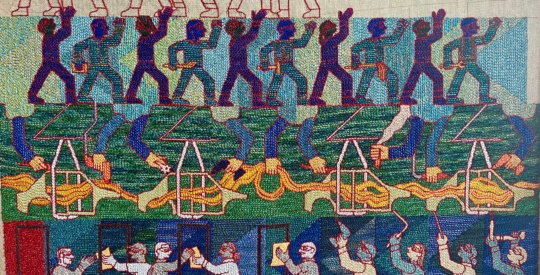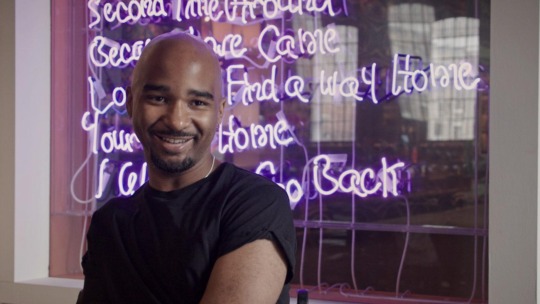
On a chilly night outside the Mattress Factory Lofts in 2008, Michi Meko sipped on whiskey, Christopher Hutchinson puffed on a cigar, and Eric Mason held his foot above a votive candle to somehow get warm as they talked shit about art. They had been hitting up art shows around Atlanta every Friday and critiquing them, symbiotically educating one another. On that fateful night, Meko suggested that they should call their think tank Smoke School of Art, with the goal of promoting black art in Atlanta. In the seven years since, Smoke School has exhibited at such art institutions as the Pinion Gallery in Miami, the Tubman Museum in Macon, Georgia, Boricua College in New York City, and the Auburn Avenue Research Library and the Underground in Atlanta.
“In the early days, there were a lot of arguments,” Hutchinson recalls. Meko introduced himself to Hutchinson when he attended the opening for “Dissolving Stereotypes/Forging New Dialogues: An Exhibition Beyond Race” at MOCA GA, which included Hutchinson’s work. Their first conversation lasted almost four hours.
“But when you think about groups of philosophers or great orators, there’s always an opposite. Christina Aguilera and Britney Spears. You can go through history, Burger King, and McDonald’s. There’s always competition,” Meko says. At the time, he described
himself as Booker T. Washington, who is hands-on, Hutchinson as W.E.B. DuBois, the philosopher, and Mason as the connection between them. And of course, they
debated about that. The first time Hutchinson entered Meko’s studio, he accidentally knocked over a painting and then proclaimed
that it might look better that way. One goal behind Smoke School of Art is to help artists learn how to explain their work to critics who might say something like Hutchinson’s remark. Meko defended his piece, and a friendship was born.
Hutchinson’s ambitious goal is to rewrite Western art history. “Primarily, the problem with Western art is the lack of vocabulary needed to discuss works of African descent,” he says. That’s a mighty cross to bear, but he claims that by looking at the work of successful African American artists and critiquing their work and questioning how they fit into the West’s art vernacular, Smoke School can develop that vocabulary. “For example, if a work has black in it, instead of automatically associating it with something ominous, as Western thought does, we appreciate black in an aesthetic form.”



Aside from these paradigm-shifting goals, Smoke School of Art is also designed to help artists continue their education post-formal schooling, not unlike the Bruce High Quality Foundation University in New York and other social practice projects. They discuss topics including feminism, Chinese art, and contemporary art, or they might focus on the basics of aesthetics. One of its members, Jason Sweet, describes life after college as being an artist alone on an island. “The one main thing that you miss is that dialogue between artists,” he says. The members of Smoke School challenge each other, agree, disagree, and debate. They push each other to the next level. Although exhibiting with Smoke School takes commitment — showing up to meetings, making work, taking critiques, and having solo exhibitions independent of Smoke School — participation is free and open to the public. But be warned, Smoke School is not a social club. If you decide to attend, be prepared to do the homework and to be challenged.
Although the group gained recognition by exhibiting as a collective, each member agrees that the educational aspect of Smoke School is paramount. The homework posted to the group’s Facebook page is discussed when they meet on Friday nights from 9pm to 2am. The group has found that even people in distant locations refer to homework as a source of art education. The founders feel that their greatest accomplishment is helping artists attain knowledge and gain acceptance in institutions of higher learning. Although critical acclaim is appreciated, Smoke School of Art is, first and foremost, a school, they say.
The name Smoke School of Art means something different to all members. When “sticks is lit”— school is in session — those who smoke cigars light them and savor the ritual of inhaling and exhaling smoke. Then the conversation begins. Sweet describes the function of smoking as clearing the space of any negativity. Carina Maye sees it as a pacing mechanism for the conversation. Whatever the reasons, when they group meets, sticks will be lit and critical thinking will transpire.
Shantay Robinson earned her MFA in Writing from SCAD. She currently hosts her blog, the Third Eye Site, which looks closely at the arts in Atlanta. She has also written artist profiles for AFROPUNK and Urban Lux Magazine. She participated in the first cycle of BURNAWAY’s Emerging Art Writers Mentorship Program.




